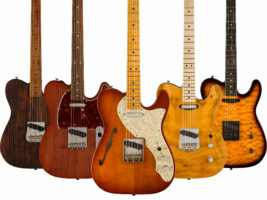
Fender launches new collection of sustainable guitars in California Streetwoods collection
Fender has launched a new collection of sustainable guitars for its new California Streetwoods collection.
Yesterday (7 August) the iconic guitar manufacturer announced the launch of its 2023 Masterbuilt collections, including the California Streetwoods collection of 13 guitars made from trees which were safely removed in California.
Every year, the Fender Custom Shop Masterbuilders design a unique collection revolving around a particular theme. Last year, there was a Hot Wheels Collection in collaboration with Mattel and Hot Wheels, and the year before there was a Surf Green with Envy Collection.
This year, the wood for the guitars is supplied by Street Tree Revival, from trees safely removed from urban forestry throughout California. They were salvaged from storms, disease, and natural deterioration. And, each masterbuilder chose their lumber by hand with help from Street Tree Revival’s John Mahoney.
So, let’s take a closer look at these one-of-a-kind guitars.
Elm Top Cabronita
Credit: Fender
This model was inspired by the desire to reintroduce the Cabronita Especial as a Masterbuilt instrument, but it’s been enhanced with a refined neck shape and a fine-tuned capacitor network for its unique sound quality. Pear tree is used for the neck, while it has an elm top and an ash body. It has a 9.5″ radius, 21 medium jumbo frets, and La Cabronita wiring and controls.
Cedar Tele
Credit: Fender
A natural NOS lacquer finish is used on this guitar to highlight the figuring in the cedar, with rear-mounted controls and no pickguard letting us see as much of the cedar as possible. It has an African blackwood fingerboard and a 3A roasted flame maple neck, as well as a ’58-’63 Tele bridge with brass barrel saddles and ’63 Tele pickups.
Ficus Strat
Credit: Fender
The influence for this guitar came from Mike Born, formerly the in-house wood expert at Fender. It has a unique pickup selector with a Novak humbucker which has a 3-position blade switch, and wood sourced from a ficus tree, as well as a quartersawn maple neck.
Shou Sugi Ban Redwood Esquire
Credit: Fender
Shou Sugi Ban is an old Japanese technique of burning and treating wood with oil, and that’s what’s been done to the California redwood used for this guitar. It provides a captivating, eye-catching finish, while there’s also a 1-piece quartersawn flame pearwood neck, 21 vintage-style frets, and a Custom Shop Josefina hand-wound loaded ’51 Nocaster bridge pickup.
Shamel Ash Tele
Credit: Fender
This model is crafted from a rare Shamel ash, and has a connection to a certain famous amusement park in Southern California. It has a NOS lacquer finish, a 4-piece Shamel ash body with maple veneer, Custom Shop Josefina hand-wound ’51 Nocaster pickups, and a 1-piece sweet gum neck with 1950 blackguard back-shape.
Bookmatched Tele
Credit: Fender
Made from elm, this guitar has a skunk-like stripe effect thanks to the look of the wood. There’s also silver maple here, which features spalted patterns and black lines that look as if they mirror the contour of a guitar’s body. The model features a 1-piece 3A flame maple neck with ’57 style soft “V” back-shape, 21 narrow tall frets, and Twisted Tele pickups.
Blonde Rosewood Tele
This model highlights the use of the sapwood part of the rosewood as a fingerboard, flowing into the rosewood top of the guitar, while there’s a contrast between the darker neck and the lighter body. It has a NOS lacquer finish, a select ash thinline body with a blonde rosewood top, and an acacia neck with a ’60s style oval ‘C’ back shape.
Quilted Maple Tele
Credit: Fender
The flame maple top of this guitar is certainly eye-catching, but the satin black hardware and black back and neck add to the visual appeal too. But it’s not a case of style over substance, as this guitar boasts a Custom Shop Josefina hand-wound loaded ’51 nocaster and Twisted Tele pickups, a ’58-’63 Tele bridge with slotted steel saddles, and a flat-lam ebony fingerboard.
Shamel Ash Strat
Credit: Fender
This guitar uses wood found in Disneyland, and has a Shamel ash body painted in a transparent ‘Green Tee’ colour and neck made from lemon-scented eucalyptus. The fingerboard glows green under the unique Black Light, while this model has a NOS urethane finish with gold hardware, and Custom Shop Josefina hand-wound ’60s strat pickups.
Roasted Ash & Elm P-Bass
Credit: Fender
This takes influence from the early slab body Precision Bass, but it’s given a modern update for peak performance. It has a 9.5″ radius, medium jumbo frets, lightweight Hipshot tuners, and a hi-mass RSD bass bridge, as well as an eye-catching figured pearwood fretboard and a one-piece elm top and back.
Himalayan Cedar P-Bass
Credit: Fender
This bound ’50s P-Bass is inspired by Himalayan cedar, and with its amber stain is reminiscent of the Gretsch round ups. It has custom inlays and a matching pick-up ring, as well as a rift sawn maple neck with a ’60s style oval ‘C’ back-shape flat-lam rosewood fingerboard. The wood comes from a tree in Christmas Tree Lane, where it’s grown since 1883 with seeds brought from Italy.
Redwood Tele
Credit: Fender
Made with figured redwood, this guitar was inspired by a love and admiration for Telecasters. The chosen spec is a classic ’60s Custom Telecaster, and this model has an NOS lacquer finish, a 2-piece select redwood body with brown shell binding, and a eucalyptus neck with a ’60s style oval ‘C’ back-shape.
Silver Maple Tele
Credit: Fender
This guitar has been given a slight relic treatment and a translucent colour for something different, while it still has a classic Thinline Tele configuration – and eye-catching silver maple leaf. It has Custom Shop Josefina hand-wound original blackguard Tele and Twisted Tele pickups, and a round-lam silver maple fingerboard.
The post Fender launches new collection of sustainable guitars in California Streetwoods collection appeared first on Guitar.com | All Things Guitar.
Source: www.guitar-bass.net











